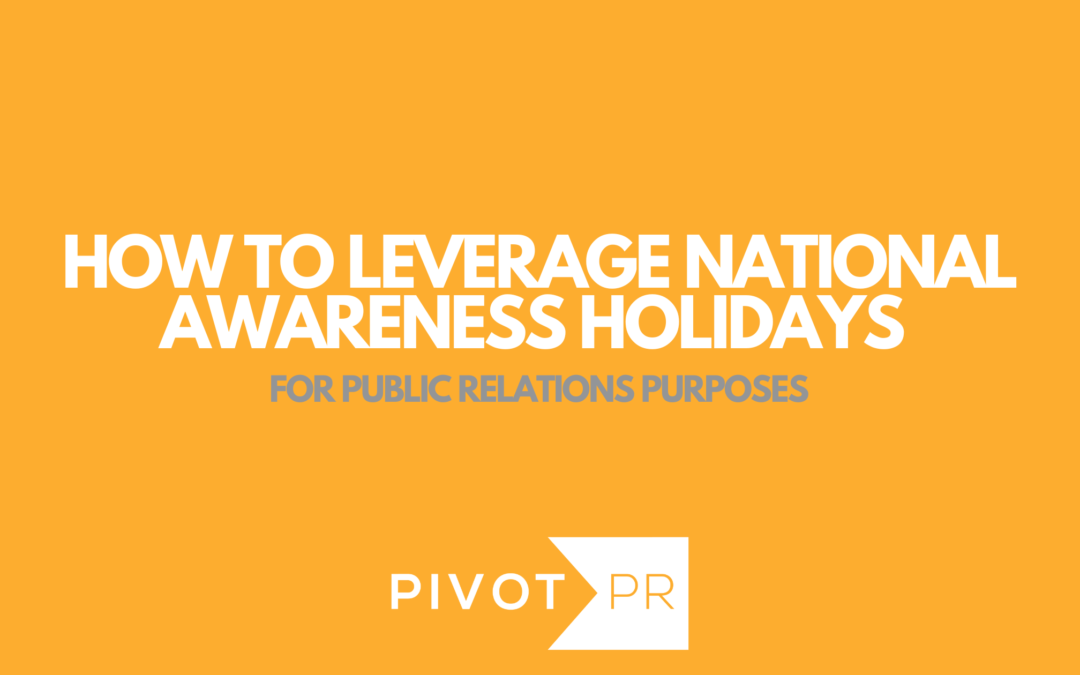
Blog
It may feel like there is a holiday for everything these days—and there practically is! While some of the more outlandish celebrations might not fit your PR strategy, many national awareness holidays provide the perfect opportunity to humanize your business, gain new exposure, and attract media attention.
Read on to learn how national awareness holidays can be implemented in your PR strategy, plus some best practices and common pitfalls to avoid.
What Are the Benefits of Using National Awareness Holidays for PR?
These special days often receive extra coverage, so they can help you get more eyes on your brand or services. Most of these events come with a slew of hashtags and keywords that will resurface annually, so it’s the ideal time to get your name trending, engage new viewers, and re-interest existing customers. Prior to a themed day, journalists will be looking for stories, events will need partners, and there will be an interested audience waiting to see what the buzz is about. Even better? Press is usually free.
What Are the Best National Awareness Holidays for PR?
The answer to this question fully depends on your niche. We recommend choosing a few topics from this calendar that naturally align with your business and could inspire a great, value-filled story. Customers are quickly turned off by content that feels forced, so if it isn’t the right fit, go back to the drawing board. That being said, do push the boundaries and get creative with your approach. See how these four vastly-different companies celebrated National Emoji Day to connect with their followers in a fun way, while also garnering press.
How Can I Ensure My Choices are Strategic?
The Google Trends tool is helpful for keeping your finger on the pulse of the topics people most want to see. Knowing these details will help you craft a timely pitch. If you’re having difficulty narrowing down your options, try researching prior media coverage. This 2022 article outlining promotions for National Coffee Day is a good sign that this holiday is popular—albeit competitive. If your search doesn’t bring up many results, the choice likely won’t yield opportunities for pitching or publicity.
How Do I Implement National Awareness Holidays into a PR Strategy?
After you’ve chosen a few events that make sense, think about your timeline. What will you need to pitch or create, and how can you maximize your reach? National awareness holidays can be extremely competitive, so we suggest getting a head start on the planning process. Involve your team and consider how you can strengthen earned media with social postings that reinforce your brand and message. And, don’t forget to incorporate plenty of relevant keywords and hashtags!
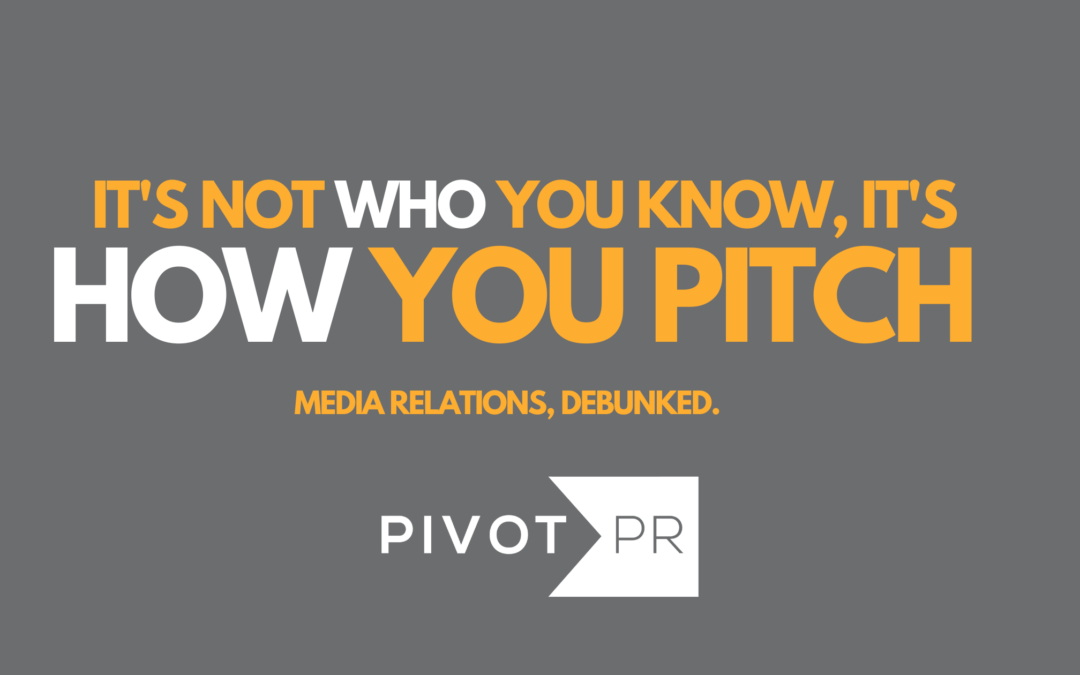
Blog
The days of a boundless rolodex equaling media placements are over. The common misconception that a public relations agency’s relationships will get your company placed in the top tier, industry, or local media is just that – a fallacy. Building and maintaining relationships with reporters is vital to a public relations practitioner’s role; however, it will not ultimately earn your company media coverage.
Storytelling reigns supreme. In today’s saturated media landscape, earned media is increasingly challenging to secure. With fewer journalists in a newsroom, frequent turnover, and pressure to monetize content, your PR practitioner must identify and tell corporate stories that stand out. Marrying your corporate story with a moment in time or a human-interest story will lead to more success in the long run.
Know the market. Media markets differ regionally, locally, and more. Therefore, picking a partner with market-specific knowledge and experience is essential to ensure a localized pitch approach. This can result in increased tailored placements and exposure to high-value audiences for your organization.
Back to basics. There is no doubt that the media environment is ever-changing. From the development of the dot com to social media, and whatever is yet to come. However, one thing remains the true north of pitching media: always go back to the basics. Nothing can substitute for a standout angle, strategic timing, sharp writing, and savvy persuasion to garner news coverage.
Of course, relationships with the media are inevitable and always good to have. Building strategic relationships across various media outlets allow for friendly, conversational-style engagements and will increase your brand awareness among publications. However, ultimately, the above criteria will drive long-term successful media campaigns, most importantly, tangible results for your organization.
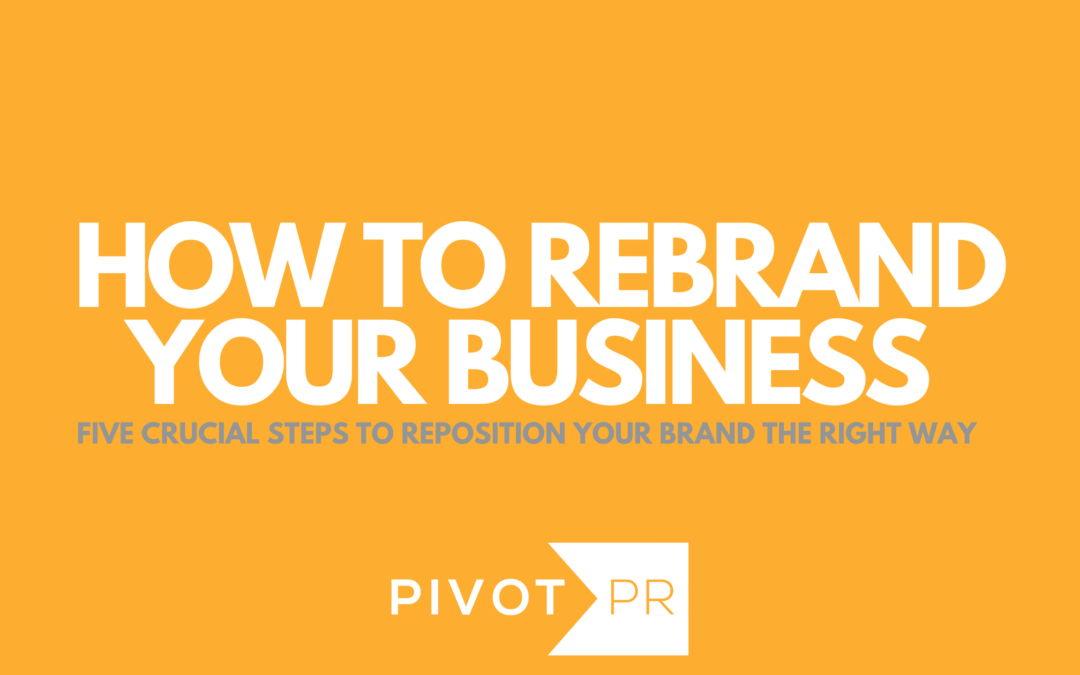
Blog
A rebrand is a marketing strategy implemented by any organization looking to change or update its brand identity in a meaningful way. It is often a response to some disconnect or error in how an organization is currently communicating with its target audience. There are numerous reasons why companies choose to undergo a rebrand, but most often it is to:
- reflect a change or expansion in the business’ services or products
- signify a merger or acquisition
- differentiate the company from industry competitors
- improve brand awareness and stay relevant in the eyes of the public
- realign the company’s image with its values and identity
- reconnect with an existing audience, or reach a new one
In all of these examples, the goal of a rebrand is to change an organization’s identity in the minds of customers, employees and other stakeholders—hopefully, for the better. It can be a large undertaking, but when done right, a rebrand can enhance a company’s relationship with customers, the media and even itself. Read below for our five-step process to executing a successful rebrand.
Five-Step Process to Execute a Rebrand
- Team Branding Session
The first step in a successful rebrand is to facilitate an interactive, thought-provoking discussion with your team about why your organization needs a rebrand, and what you want the rebrand to achieve long-term. A great way to answer these questions is to start with the end in mind. What do you want your customer experience to look like in five years? Would you like to expand the types of products or services you offer, or who you sell them to? How do you see your audience evolving over time?
- Competitive Analysis
Conducting a comprehensive analysis of local, regional and even national competitors in your industry is an effective way of better understanding which branding and communications trends resonate the most with your target audience—and which miss the mark. It also gives your organization an idea of how it can differentiate itself from the competition, and provides clarity on who is, or is not, buying from you. Through this research, you will likely make observations about your audience or your industry that contradicts your preexisting beliefs about them; These discoveries are both important and beneficial in determining how your organization wants to reposition itself in the future.
- New Brand Formulation
Determining what is and isn’t “working” for your organization is half the battle—next, you must use what you’ve learned through your research and analysis to develop something altogether new. While your brand encompasses your reputation and visibility, your brand identity is the visual shorthand that can make you recognizable and memorable. So, updating your name, logo, colors, typography and imagery are some of many great ways to alter public perception of your organization. To make brand implementation easier later on (see Step #4), compile these visual elements into a style guide that can be easily referenced by employees and the media. Feel free to brainstorm a variety of creative options—just make sure to leave time for feedback and revisions too.
- Brand Implementation
Once you have an idea of what the “new you” looks like and sounds like, you must update any digital or print collateral to reflect these changes. Use the directions, applications and examples provided in your company’s style guide to ensure that your brand is implemented consistently across all marketing materials, including pitch decks, proposal templates, and one-sheet flyers.
- Internal/External Announcement
Finally, it’s time to announce your company’s rebrand to the public. With help from your new style guide, develop consistent, clear messaging and content that explains what and why your organization decided to undergo a rebrand. This may include press releases or a messaging document. Then, share this collateral with relevant stakeholders, such as customers and the media.
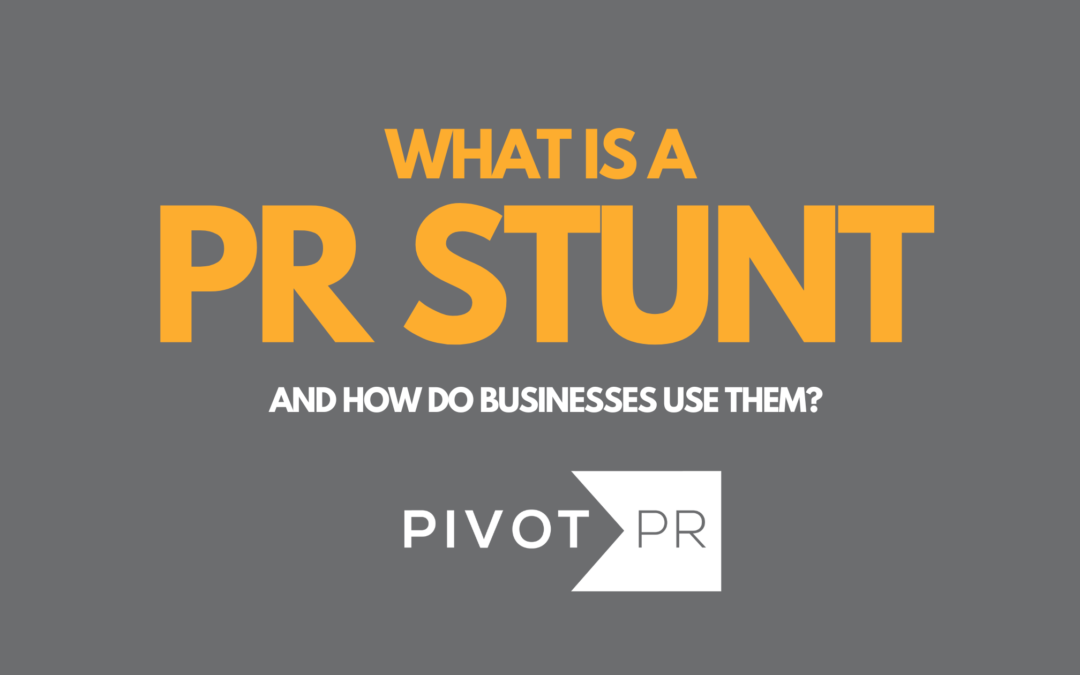
Blog
A PR stunt, or publicity stunt, is a coordinated public relations event intended to raise positive awareness about a brand, product, cause or event. While this overarching goal is similar to that of a TV commercial or billboard, PR stunts are set apart in how they gain attention. Unlike traditional advertising and marketing tactics, these events typically take a more unique and memorable approach to engage with their target audience. With bold, eye-catching (and sometimes “over the top”) stunts, brands can differentiate themselves and leave a lasting impression that, ideally, earns mass media coverage.
For a PR stunt, getting people talking is the biggest win, and one of the most proven ways to do so is getting an audience involved. An interactive campaign that allows people to “participate in the fun” gives them reason to share the experience with others, translating into sales, donations and support for your brand.
Contrary to popular belief, not all PR stunts have to be elaborate and grandiose—nor do they need a big budget. While a 30-second TV commercial can cost hundreds of thousands of dollars, PR stunts can offer an unmatched return on investment for far less money. In fact, the greatest resource in developing a successful event isn’t money at all, it’s creative thinking. On the flip side, the biggest expense behind a PR stunt is the inherent risk of trying something new.
How can your business use a PR stunt to gain positive media exposure? Tips and questions to ask your team when planning an event.
- Identify your media goals. We know that a PR stunt aims to be “outside-the-box” enough that you are memorable, but what do you want to be remembered for? Are you trying to build general brand awareness, or promote a specific product or service? Do you want to fundraise, or generate more website traffic? No matter what PR tactic you use, if you don’t know what you’re hoping to achieve in the first place, you won’t be able to measure the success of your efforts.
- Get to know your audience. Once you’ve determined who your target clients, stakeholders and customers are, do your research! What do they care about? What triggers their attention, or what has in the past?
- Consider the risks. A PR stunt can significantly improve your brand’s reputation, but if you aren’t careful, it can also cause serious damage to your image. Throughout the planning process, ask for feedback from people outside of your organization. People can (and are known to) interpret PR stunts in a variety of unexpected ways, so the more perspective you have on possible response to your event, the less likely it will be to backfire.
- Evaluate success. As outlined in tip #1, identifying your PR goals first is necessary for evaluating performance later. While going “viral” across TikTok, Instagram, Twitter and Facebook have become widely regarded as the gold standard for public relations success, identifying specific metrics, such as increased Google searches, or mentions and shares on social media, will help you determine whether your PR stunt achieved what it set out to do.
- Prepare to be flexible. Even with the most seasoned public relations professionals at the helm, PR stunts don’t always go according to plan. Just as it is important to evaluate the possible risks and negative consequences, it is equally necessary to have a mitigation plan in place so that, if things go awry, your brand can efficiently and professionally adapt.

Blog
Carlie recently had the opportunity to sit down with Alexandria Sands, a new reporter at Axios Charlotte. Check out their conversation about Alex’s journey in journalism and Charlotte homecoming!
Tell me about yourself… where are you from and what brought you to Charlotte?
“My name is Alexandria Sands, but you can call me Alex! I grew up in Apex, North Carolina and studied at UNC Charlotte because I loved the campus and the city. After graduating, I moved to Leland and worked in Southport at their newspaper, where I had worked as an intern during college. From there I went to a Wilmington virtual newspaper, Port City Daily, for about a year. It was then that I realized I wanted to come home to Charlotte, so I applied at Axios and here I am! I stayed up to date on Charlotte news while at my other jobs and realized I wanted to be a part of covering some of the bigger stories that were developing in the Queen city.”
How did you get interested in journalism?
“Back when I was in middle school, I got my first camera as a gift and brought it everywhere. My parents suggested that I was going to be a photojournalist when I grew up, and that really stuck with me! Later in high school I did yearbook and newspaper as extracurriculars, slowly writing more than I was taking photos. By the time I got to UNC Charlotte, writing had become my biggest passion. I joined The Niner Times and devoted myself to improving those skills while working a few internships on the side. I juggled four internships while being a full-time student but loved what I did so I just kept going!”
How did the opportunity come about to join Axios and what are your goals as a reporter at Axios?
“I had previously worked with Emma Way (now deputy managing editor of Axios local) through my previous internship at Charlotte Magazine, so that was my connection to Axios. I’ve always looked up to a lot of the writers at Axios, especially Michael Graff (Axios Southern bureau chief) and Katie Peralta Soloff (Axios editor). I’ve also always admired Axios’ format, so I was eager to become a part of that. Axios does a great job of focusing on the reader and their needs, making access to news as quick, convenient and accessible as possible. I aim to respect our readers’ time and get to the point in why the news matters to them specifically.”
How would you describe Axios in three words?
“Innovative, informative and fun!”
What is on the horizon for Axios?
“We just got acquired by Cox Media and are planning to expand to multiple cities across the country. The goal in those new markets is to provide similar coverage to what Axios Charlotte does in the local community and beyond.”
What kind of news do you find most interesting to report on?
“I personally gravitate toward smaller stories that make you feel connected to your community as well as bigger picture, progressive stories that focus on what Charlotte is becoming and where the city is headed.”
What is the most valuable lesson you have learned so far while working in the journalism industry?
“I’ve found that we are all so caught up in our phones, work and personal lives. Journalism for me provides the unique opportunity to pause what’s going on in my own life and focus on understanding another person in a very deep way that I would likely not get to do in another career. Journalism has helped me to appreciate that every person you pass on the street has a story and the opportunity to tell that story to the best of my ability.”
Where do you see yourself in five years’ time?
“I am very committed to staying in Charlotte and evolving as a journalist that serves my local community. I want to contribute to the community in a positive, impactful way and gain Charlottean’s trust in delivering them news related to Charlotte and beyond.”
To learn more about Axios Charlotte and stay up to date on local news, be sure to join 113,687 smart Charlotteans who wake up to the Axios Charlotte newsletter each morning at 6 a.m.
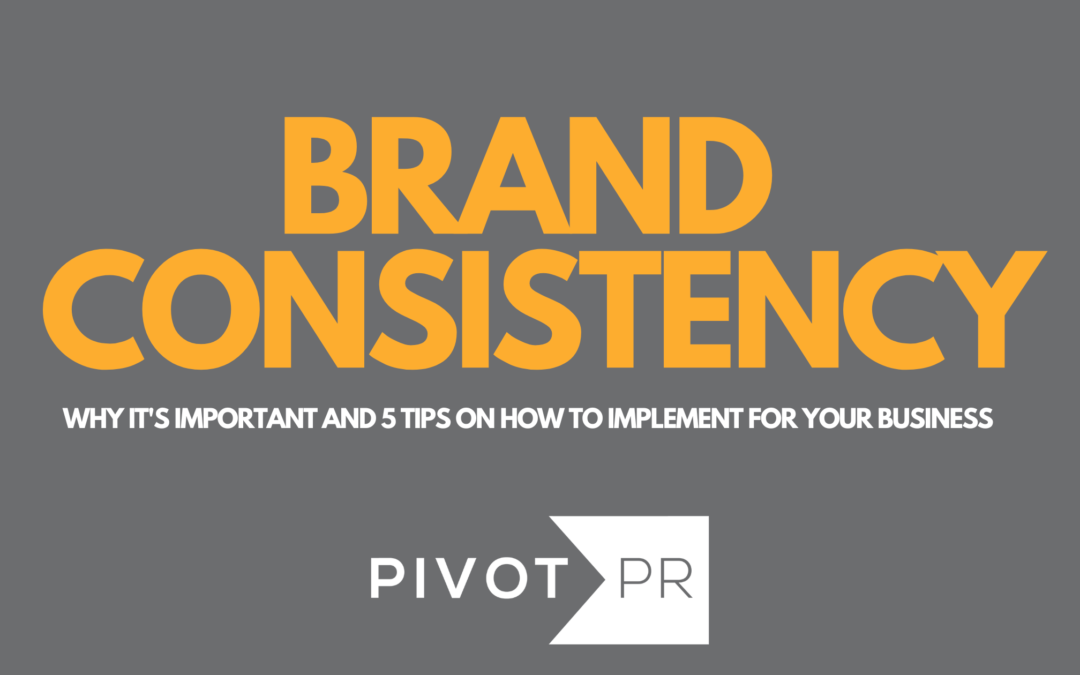
Blog
If the whole point of “branding” your business is to publicly distinguish it from others like it, then wouldn’t posting the same messages, information and types of content over and over again be redundant and boring? Not quite. Repetition of the same language and visual elements is actually one of the most proven ways to place your brand in the forefront of your target audience’s mind. And the reason lies in human psychology.
Compared to other species, human beings are largely known for their social, relationship-driven nature. We have an innate desire to “belong,” and often satisfy our need for community by building relationships with those we trust. And while humans may consider themselves to be logical creatures, the reality is almost all our decision-making is led by the emotional side of our brain. Therefore, it follows that when we determine who and what we want to associate ourselves with, we are doing so based on whether we feel they deserve our trust in the first place.
Branding works the same way. For an organization to gain (and retain) the attention of its target audience, it must give that audience reason to believe it is trustworthy. That is, if you want people to follow, share and interact with your content on a regular basis, these people must feel confident that your brand will follow through on its mission and values. Every single time.
But if your audience isn’t familiar with your organization, how can they trust you?
This is where brand consistency comes into play. The best way to become recognizable across numerous media channels is to present a clear and consistent identity of colors, logos, visuals, messages—even emotions—that viewers can associate with your brand. Do it enough, and these elements will eventually become synonymous with your brand, making it easy for people to not only recognize, but want to interact with you.
How can you build and reinforce a consistent brand image?
Consistency gives people the confidence to expect the same user experience every time—translating into sales and repeat customers. Here are a few ways to achieve this:
- Make your approved branding materials easily accessible to all members of your organization. This can include branded icons and logos, social media templates, boilerplates and mission statements, fonts and color palettes. If these elements aren’t readily available, people will deviate—or worse, they will try to recreate “similar” (but surely off-brand) elements on their own!
- Furthermore, it is important to have an established set of brand guidelines that employees can follow. With these guidelines, people will know how and when to use branded materials. Brand guidelines can also include descriptions of proper tone and voice, grammatical and stylistic preferences and even a reference list of competitors with similar brands.
- Create a schedule for social media posts, newsletter distribution, quarterly updates and shareholder reports. People will come to expect your content—you don’t want to confuse them or leave them hanging.
- Don’t forget about other touchpoints aside from social media. Your audience interacts with your brand any time they make a purchase, contact human resources, or ask to speak with a sales representative. Turn your employees into brand ambassadors by training them to present your brand right.
- Perform regular brand audits. One of the biggest challenges organizations face with maintaining brand consistency is exactly that—the maintenance. As your team, audience or services grow, it is easy for your communications to become misaligned with what you originally intended for them to be, so make sure you are occasionally reviewing how your brand is presenting itself.





